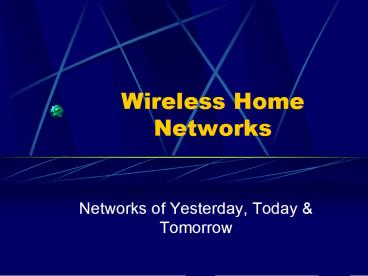Wireless Home Networks PowerPoint PPT Presentation
1 / 12
Title: Wireless Home Networks
1
Wireless Home Networks
- Networks of Yesterday, Today Tomorrow
2
Table of Contents
- Home Wireless Networks of Yesterday pg 3
- Home Wireless Networks of Today pgs 4-5
- Home Wireless Networks of Tomorrow pgs 6-7
- The 802.11 Technology Series pgs
8-9 - Pros Cons
pg 10 - Footnotes
pg 11 - Bibliography
pg 12
3
3. Home Wireless Networks of Yesterday
- HomeRF was the first practical wireless
home-networking technology.1 - It was launched in mid 2000, and provided a
maximum transfer rate of 1.6 Mbps.1 - 802.11 was also available at this time, but less
popular because it was more expensive.1 - 802.11 existed as two versions, and their
transfer speeds ranged from 1 2 Mbps.1
4
4. Home Wireless Networks of Today
- As bandwith increases, the ability to share
information with other home appliances becomes
much easier.2 - Phillips and Sony have developed ways to stream
high-definition video wirelessly, using 802.11a
technology.3 - Gaming consoles, for example PS2, are capable of
managing music, video distribution, and instant
communication.3
5
5. Wireless Networks of Today Continued
- MSN TV 2 Internet Media Player allows you to
use your home network to display photos that
reside on your PC on your TV.4 - MSN TV also allows you to watch Windows
Media-compatible video clips, movie trailers,
sports highlights and other online media that is
stored on your PC on your TV.4 - Security wise, 802.11i has improved security, and
it focuses on authentication, encryption, and
message integrity.3
6
6. Wireless Networks of Tomorrow
- The players involved with 802.11n are talking
about quoted data rates of up to 250 Mbps and
actual data rates of up to 175 Mbps.6 - Then there's a prototype connectivity technology,
backed by Intel and others, that is a subset of
ultra wideband wireless USB (WUSB). The expected
data rate of wireless USB is 480 Mbps at a range
of 2 meters and 110 Mbps at 10 meters. These very
high data rates at close range would enable you
to do things like point a camcorder at a PC and
stream video wirelessly to the computer.6
7
7. Networks of Tomorrow Continued
- In home security, futurists see devices such as
smart, Web-connected cameras and robots playing a
role.6 - Sony, and others are at work developing
next-generation IP cameras that can help
homeowners keep an eye on their houses from
wherever they are. You might find numerous
wirelessly connected cameras inside and outside a
home, each with its own IP address, motion
sensor, remote tilt and swivel controls, and Web
server features.6 - Robotic vacuums, digital washing machines that
can control water flow for different kinds of
loads, and refrigerators with built-in LCDs
already exist, but haven't found their niche
quite yet.6
8
8. The 802.11 Technology Series
- The 802.11 technology will be what wireless
networks are based on. The 802.11 various flavors
are listed below.3 - 802.11a has a 54Mbits/sec link speed, and can
deliver a maximum usable throughput of about
25Mbits/sec. It uses a 5GHz carrier frequency,
which helps it steer clear of microwave ovens and
cordless telephones.5 - 802.11b has a maximum link speed of 11Mbits/sec,
and a peak usable throughput of around
5Mbits/sec.5 - 802.11g offers a maximum link speed of
54Mbits/sec, and maximum usable throughput of
around 20Mbits/sec, four times better than
802.11b, and not much slower than 802.11a.5
9
9. 802.11 Series Continued
- 802.11e adds Quality of Service (QoS)
functionality that's nearly identical to that
found in 802.1d standard used in the wired
Ethernet world. It is especially key to allowing
802.11 to stream video, audio and voice in real
time.5 - 802.11i improves the notoriously poor security
for wireless networks, with improvements in the
area of authentication, encryption, and message
integrity. 802.11i includes AES (Advanced
Encryption Standard), which is a much stronger
encryption than what's found on past-generation
802.11 networks.5
10
10. Pros Cons of Wireless Networking
- Pros
- Frees you from network cables.
- Less analog, less time required to carry out
specific tasks.
- Cons
- More expensive than wired, phone-line, or
power-line alternatives. - Difficulty with bandwith.
- Security
11
11. Footnotes
- Bruce Brown,Wireless Home-and Small-Office
Networking - Dave Salvator,Building a Wireless Home Media
Network Server - Craig Ellison, Networking Whats Next
- More About Getting Networked
- Dave Salvator, Picking the Right Topology
- Sebastian Rupley, Your Future Home
- Bruce Brown, Proxim Symphony- HRF Wireless
Debuts
12
12. Bibliography
- Brown, Bruce Proxim Symphony- HRF Wireless
Debuts. - Brown, Bruce Wireless Home- and Small-Office
Networking. - Ellison, Craig Networking Whats Next.
- Rupley, Sebastian Your Future Home
- Salvator, Dave Building a Wireless Home Media
Network Server - Salvator, Dave Picking the Right Topology
- MSNTV.com More About Getting Networked
- Doe, Tahriq CompUSA 770-640-6990

